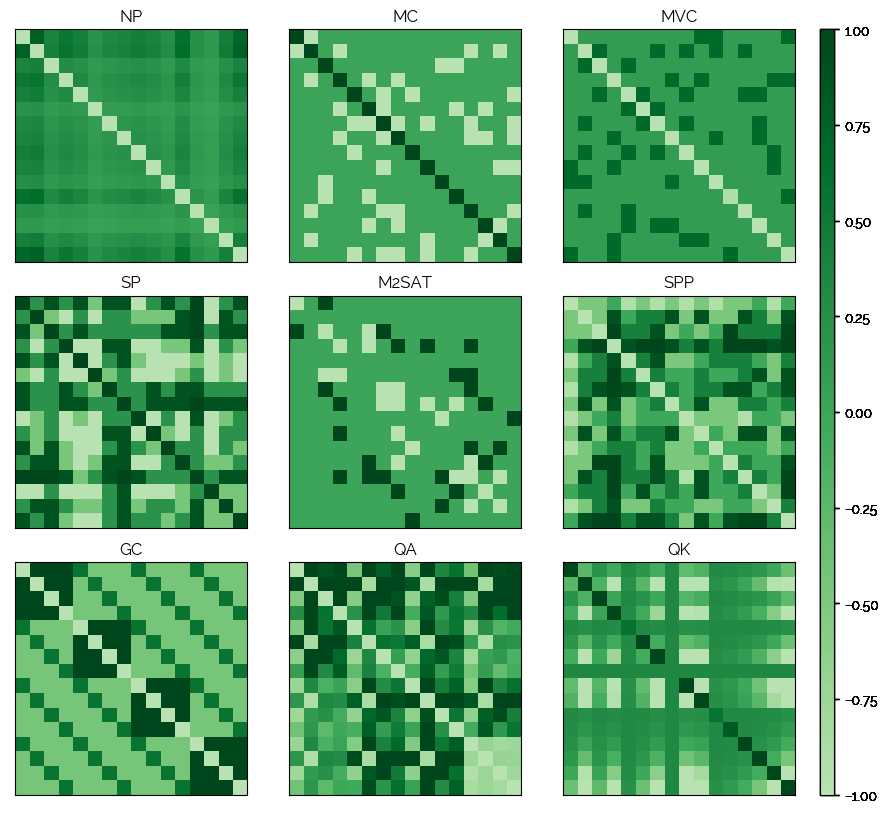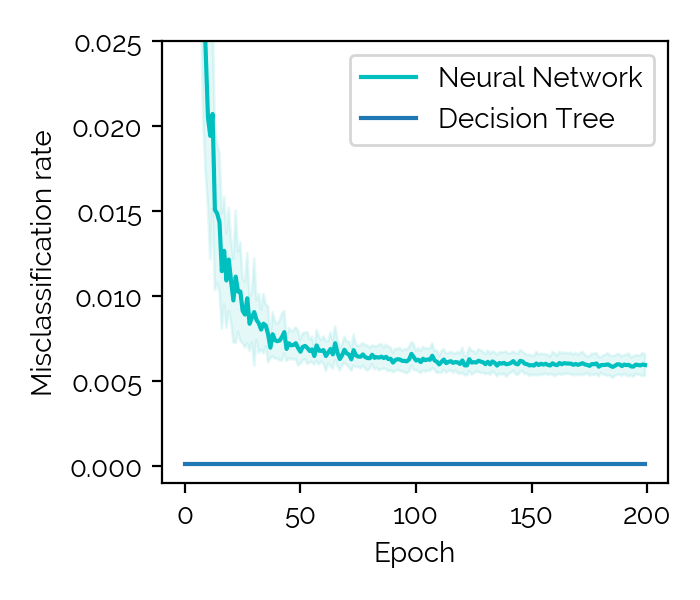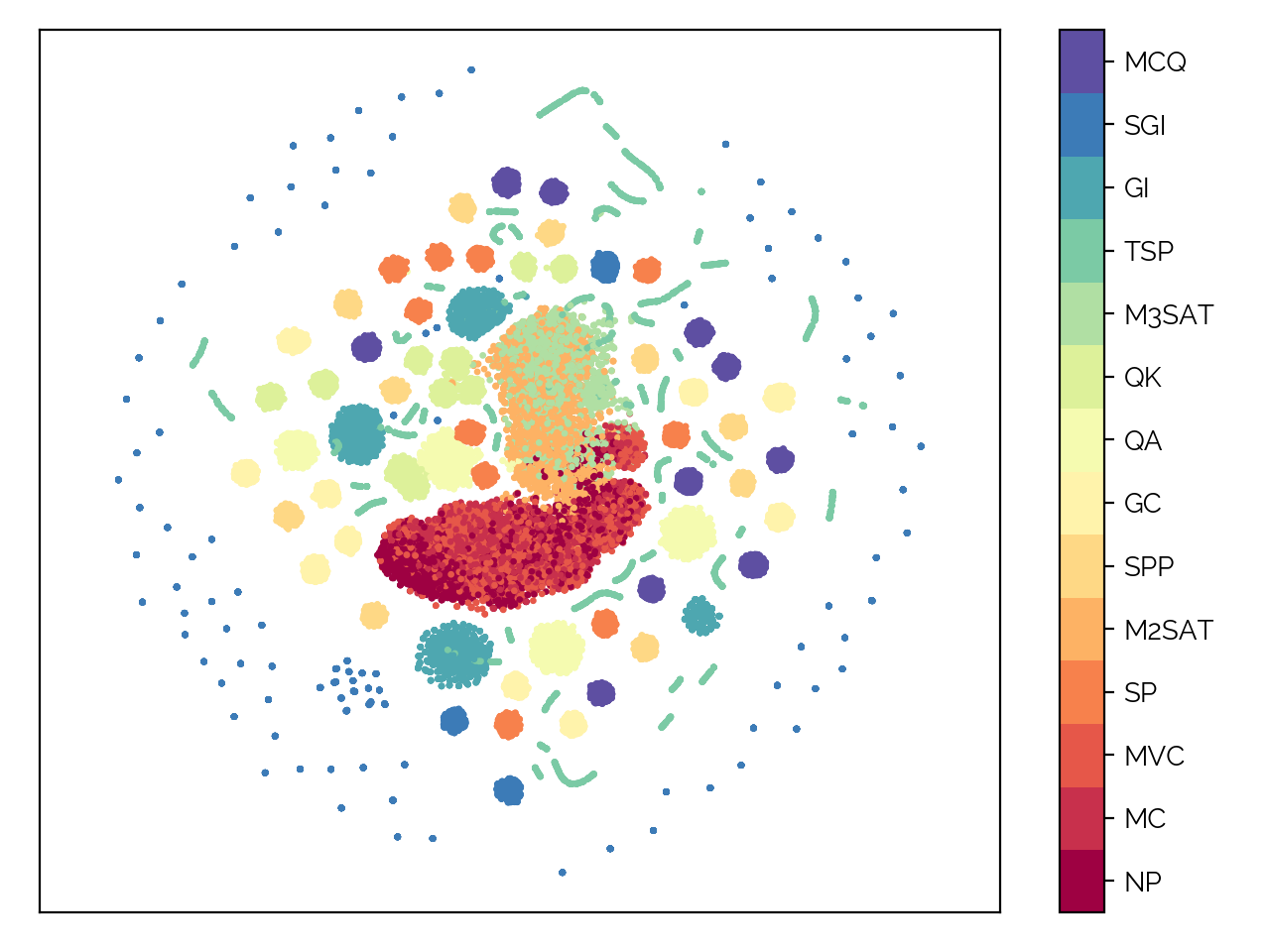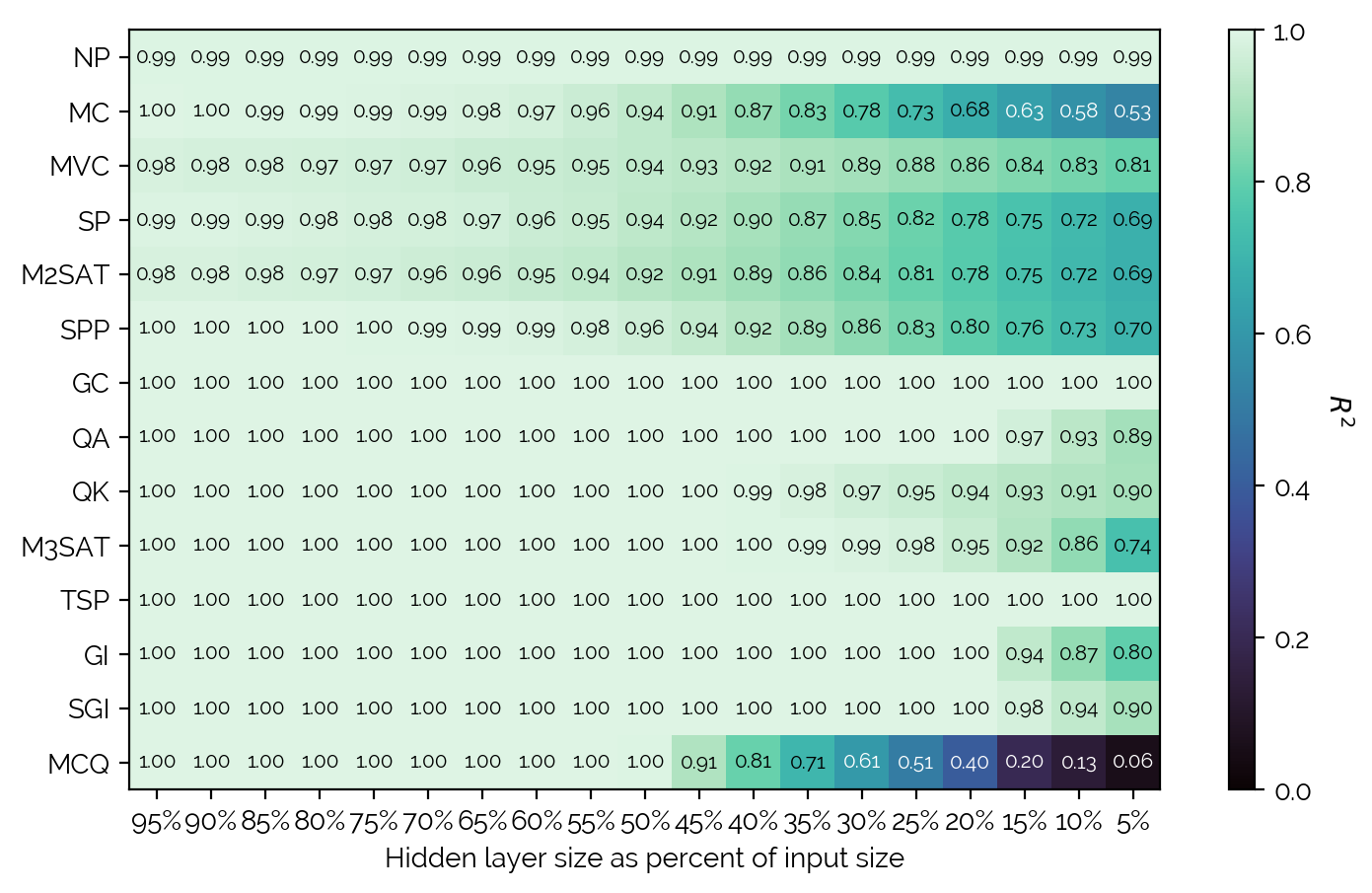QUBO translations for 14 problems. Also: Reverse-engeering and AutoEncoders for QUBOs.
Project description
QUBO - NN

9 problems and their respective QUBO matrices.
QUBO matrices are used to describe an optimization problem as a matrix such that a Quantum Annealer (such as a D-Wave QA) can solve it.
Now, these matrices are quite an interesting construct.. Thus, a few questions arise:
- Is it possible to classify the problem class based on the QUBO matrix?
- Is it possible to reverse-engineer the problem parameters that led to a QUBO matrix?
Let's find out.
Project Structure
| File | Purpose |
|---|---|
| datasets/ | Contains generated datasets. |
| models/ | Contains trained models. |
| nn/ | Contains neural network models. |
| plots/ | Contains plotting scripts and generated plots. |
| problems/ | Contains generators and evaluators for specific problems such as 3SAT or TSP. |
| runs/ | Contains tensorboard logging files. |
| config.py | Configuration (json) handling. |
| data.py | LMDB data handling. |
| main.py | Main entry point. |
| pipeline.py | End to end training and testing of NNs on QUBO matrices. |
| simulations.json | All experiments and configurations. |
Problems implemented so far:
- Number Partitioning
- Maximum Cut
- Minimum Vertex Cover
- Set Packing
- Maximum 2-SAT
- Set Partitioning
- Graph Coloring
- Quadratic Assignment
- Quadratic Knapsack
- Maximum 3-SAT
- Travelling Salesman (TSP)
- Graph Isomorphism
- Sub-Graph Isomorphism
- Maximum Clique
Setup
pip3 install -r requirements.txt
pip3 install -e .
Using
Classification / Reverse regression
usage: main.py [-h] [-t TYPE] [--eval] [--gendata] [--train] [-c CFG_ID] [-m [MODEL]] [-n [NRUNS]]
optional arguments:
-h, --help show this help message and exit
-t TYPE, --type TYPE Type (classify, reverse)
--eval
--gendata
--train
-c CFG_ID, --cfg_id CFG_ID
cfg_id
-m [MODEL], --model [MODEL]
-n [NRUNS], --nruns [NRUNS]
Examples for classification:
python3 -m qubo_nn.main -t classify -c 2 --train
python3 -m qubo_nn.main -t classify -c 2 --eval -m models/21-02-16_20\:28\:42-9893713-instances-MacBook-Pro.local-2
Examples for reverse regression:
python3 -m qubo_nn.main -t reverse -c tsp1 --gendata
python3 -m qubo_nn.main -t reverse -c tsp1 --train -n 1
Generating QUBOs for arbitrary problems
This is an example on how to create a MaxCut instance and generate a QUBO matrix for it:
>>> graph = networkx.Graph([(1, 2), (1, 3), (2, 4), (3, 4), (4, 5), (3, 5)])
>>> problem = MaxCut(graph)
>>> matrix = problem.gen_qubo_matrix()
[
[2, -1, -1, 0, 0],
[-1, 2, 0, -1, 0],
[-1, 0, 3, -1, -1],
[0, -1, -1, 3, -1],
[0, 0, -1, -1, 2]
]
The list of problems can be found in qubo_nn/problems/__init__.py. Also:
>>> from qubo_nn.problems import PROBLEM_REGISTRY
>>> PROBLEM_REGISTRY
{
'NP': <class 'qubo_nn.problems.number_partitioning.NumberPartitioning'>,
'MC': <class 'qubo_nn.problems.max_cut.MaxCut'>,
'MVC': <class 'qubo_nn.problems.minimum_vertex_cover.MinimumVertexCover'>,
'SP': <class 'qubo_nn.problems.set_packing.SetPacking'>,
'M2SAT': <class 'qubo_nn.problems.max2sat.Max2SAT'>,
'SPP': <class 'qubo_nn.problems.set_partitioning.SetPartitioning'>,
'GC': <class 'qubo_nn.problems.graph_coloring.GraphColoring'>,
'QA': <class 'qubo_nn.problems.quadratic_assignment.QuadraticAssignment'>,
'QK': <class 'qubo_nn.problems.quadratic_knapsack.QuadraticKnapsack'>,
'M3SAT': <class 'qubo_nn.problems.max3sat.Max3SAT'>,
'TSP': <class 'qubo_nn.problems.tsp.TSP'>,
'GI': <class 'qubo_nn.problems.graph_isomorphism.GraphIsomorphism'>,
'SGI': <class 'qubo_nn.problems.subgraph_isomorphism.SubGraphIsomorphism'>,
'MCQ': <class 'qubo_nn.problems.max_clique.MaxClique'>
...
}
Results
The pipeline of interest is as follows.

Given some QUBO matrix that was generated using a set of problem parameters, we first classify the problem in step a and then predict the parameters in step b.
Classification
Using parameter configuration 100_genX (see simulations.json), the average
total misclassification rate over 20 models goes to near zero. The figure
includes the 95% confidence interval. Scrambling QUBOs leads to a nearly
similar effect. Note that this is using a generalized dataset, i.e. the dataset
consists of not just 64x64 QUBO matrices for each problem, but also smaller
sizes such as 32x32. The smaller sizes are zero-padded to the biggest supported
size, which most of the time is 64x64 and in rare cases goes up to 144x144 (for
Quadratic Assignment).

The t-SNE plot for this experiment is shown below.

Reverse regression
This is preliminary. Some of the problems are easily learned by a neural network regressor. Each line represents 10 models and includes the 95% confidence interval.


Reversibility
This shows whether we can deduce the parameters that led to a QUBO matrix, given we predicted the problem beforehand. A lot of the graph based problems are easily reversable since the graph structure is kept intact in the QUBO matrix. Thus we can recreate the graph and other input parameters given a GraphColoring QUBO matrix.
This is still WIP - needs testing. These are hypotheses.
Reversing some problems like Quadratic Knapsack might be possible - an algorithm is an idea, but one could also make their life easy and try fitting a NN model to it.
| Problem | Reversibility | Comment |
|---|---|---|
| Graph Coloring | + | Adjacency matrix found in QUBO. |
| Maximum 2-SAT | ? | Very complex to learn, but possible? C.f. m2sat_to_bip.py in contrib. |
| Maximum 3-SAT | ? | Very complex to learn, but possible? |
| Maximum Cut | + | Adjacency matrix found in QUBO. |
| Minimum Vertex Cover | + | Adjacency matrix found in QUBO. |
| Number Partitioning | + | Easy, create equation system from the upper triangular part of the matrix (triu). |
| Quadratic Assignment | + | Over-determined linear system of equations -> solvable. P does not act as salt. A bit complex to learn. |
| Quadratic Knapsack | - | Budgets can be deduced easily (Find argmin in first row. This column contains all the budgets.). P acts as a salt -> thus not reversible. |
| Set Packing | - | Multiple problem instances lead to the same QUBO. |
| Set Partitioning | - | Multiple problem instances lead to the same QUBO. |
| Travelling Salesman | + | Find a quadrant with non-zero entries (w/ an identical diagonal), transpose, the entries are the distance matrix. Norm result to between 0 and 1. |
| Graph Isomorphism | + | Adjacency matrix found in QUBO. |
| Sub-Graph Isomorphism | + | Adjacency matrix found in QUBO. |
| Maximum Clique | + | Adjacency matrix found in QUBO. |
Redundancy of QUBOs with AutoEncoders
The figure below shows that there are major differences between problem classes in terms of their overall redundancy.

Contributing
Pull requests are very welcome. Before submitting one, run all tests with ./test.sh and make sure nothing is broken.
References
Glover, Fred, Gary Kochenberger, and Yu Du. "A tutorial on formulating and using qubo models." arXiv preprint arXiv:1811.11538 (2018).
Michael J. Dinneen, "Maximum 3-SAT as QUBO" https://canvas.auckland.ac.nz/courses/14782/files/574983/download?verifier=1xqRikUjTEBwm8PnObD8YVmKdeEhZ9Ui8axW8HwP&wrap=1
Lucas, Andrew. "Ising formulation of many NP-problems. Frontiers in Physics" (2014)
Cristian S. Calude, Michael J. Dinneen and Richard Hua. "QUBO Formulations for the Graph Isomorphism Problem and Related Problems" (2017)
Related Work
Hadamard Gate Transformation for 3 or more QuBits
QUBOs for TSP and Maximum-3SAT
QUBO-NN - Reverse-Engineering QUBO matrices
A note on Adiabatic Evolution in Quantum Annealing
Project details
Download files
Download the file for your platform. If you're not sure which to choose, learn more about installing packages.











